Public transport in Mumbai
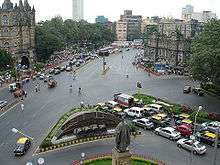
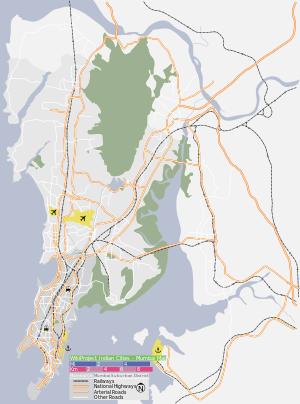
Public transport in Mumbai involves the transport of millions of its citizens by train, road and water. Over 88% of the commuters in Mumbai use public transport. Mumbai has the largest organised bus transport network among major Indian cities.
Mumbai's public transport consists primarily of rapid transit on exclusive suburban railway lines augmented by commuter rail on main lines serving outlying suburbs, the bus services of the three municipalities making up the metropolitan area, public taxis and auto rickshaws, as well as ferry services. A metro and a monorail system have recently been inaugurated. A commercial Seaplane Service has recently been introduced.[1]
Bus
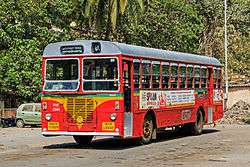
- Brihanmumbai Electric Supply and Transport (BEST) has a fleet of single and double decker buses. Air conditioned Kinglong buses were supposed to be ordered to modernize the fleet, but Ceritas buses from Punjab were quietly bought instead. These frequently break down and hold up traffic due to their poor quality of engineering.[2] Senior leadership of the BEST has refused to comment on the issue.[3]
- Navi Mumbai Municipal Transport (NMMT) operates air conditioned Volvo buses from Navi Mumbai to Bandra, Dadar & Borivali and non A/C buses from Navi Mumbai to Mulund (East and West).
- Kalyan-Dombivli Municipal Transport(KDMT)operates buses in Kalyan and Dombivli and to areas in Navi Mumbai such as Nerul,Vashi,Panvel,Kharghar & Belapur CBD.
- Thane Municipal Transport (TMT) operates their buses from Thane to Mulund and Borivali.
- Mira-Bhayandar Municipal Transport (MBMT) operates their buses from Mira-Bhayandar to Jogeshwari and Borivali.
- Vasai-Virar Municipal Transport (VVMT) operates their buses from Vasai-Virar to Mulund, thane and Bhivandi.
Railway Network


The Mumbai Suburban Railway is the oldest in Asia, founded in 1867. It is owned by Indian Railways and operated by its Western Railways and Central Railways divisions. With a length of 303 km, it has highest passenger density in the world, 6.3 million people daily, which is more than half of daily capacity of Indian Railways. It has four radial lines:
- Western between Churchgate railway station and Dahanu Road
- Central between Chatrapati Shivaji Terminus (CST) and Kasara/Khopoli
- Harbour, running between CST and Panvel/Andheri
- Trans-Harbour, running between Thane and Vashi/Panvel
Mumbai railways offer first class commuter transport. First class fares are approximately 10 times the second class fare[4] and therefore tend to be less crowded in the non rush hour period. First class compartments also have slightly better seats than second class. less crowded compartments during non peak hours, the first class compartments are rather more crowded during the peak hour time, as there is a large supply and demand gap.Its notoriously hard to get into the first class compartment as the coach is overcrowded with people hanging out of the doors.
There are also women-only cars (termed 'ladies'),[4] and since 1992, 'Ladies Special' trains with all coaches reserved for women passengers.
The Mumbai suburban railway network is constantly struggling to cope with the growing population.
Metro
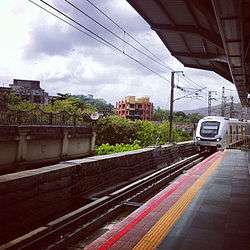
In January 2004, a master transit plan was unveiled by the Mumbai Metropolitan Region Development Authority (MMRDA). The plan integrated a 146 kilometre-long metro system, of which 32 km would be underground.
In June 2004, government approval was given for a 13-station elevated line between Ghatkopar, Andheri and Versova. In June 2006, the first phase of the Mumbai Metro project was inaugurated. Construction work began in February 2008.[5][6][7] A successful trial run was conducted in May 2013, and the system's first line entered operation in June 2014,[8][9][10] although some aspects of the project were afflicted by delays and cost issues.[6][11][12][13] The Mumbai Metro ridership started from 8 June 2014
Monorail
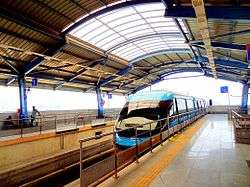

The Mumbai Monorail is a monorail system for the city of Mumbai. Construction began in January 2009 and the first operational line was inaugurated on 1 February 2014.[14][15] It is being contracted by the Mumbai Metropolitan Region Development Authority and is the first monorail in India.[16]
There are four lines proposed. The first two are 25 kilometres (16 mi) long. Out of the two, construction on the first line has begun.
- A line running from Malabar Hill to the Bandra-Kurla complex via the Haji Ali Dargah, Jacob Circle, Wadala Road, Sion Hospital and Dharavi. This is planned to have been opened by 2011.
- A line from Thane to Bhiwandi via Kalyan. A consultant's report has recommended to government that this corridor be instead served by a road-based system for the next 10–15 years utilizing buses and bus rapid transit.[17]
Two lines 10 kilometres (6.2 mi) long are to be constructed after the first two have opened.
- Chembur to Jacob Circle via Mahul. This route is planned to have been opened by December 2010.[18] (May get extended to Vashi, Navi Mumbai.)
- Lokhandwala Complex to Kanjurmarg via Oshiwara.
Additionally, previously planned Mumbai Metro corridors are also being examined to be made as monorail corridors instead of metro by MMRDA due to the dense and congested areas these corridors pass through. The corridors are:
- Hutatma Chowk – Ghatkopar – 21.8 km
- Ghatkopar – Mulund – 12.4 km
Trams

Trams were an important form of transport until the mid 1960s. They were introduced by the then British government, in the late 19th century and in their heyday, covered many areas of the city. At one stage, their length grew to more than 47 kilometres.[19]
Taxis
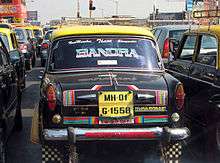
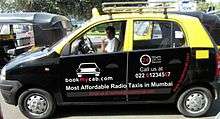
Taxis arrived in 1911 to complement horse wagons. Black and yellow Fiat taxis are an integral part of the city's heritage and have been depicted in numerous Bollywood movies. Metered taxis ply throughout Mumbai and have a monopoly from Bandra to Churchgate on the Western line and Sion to Chatrapati Shivaji Terminus on the Central line. Beyond Sion and Bandra auto rickshaws are not allowed and one has to hire a taxi. However, between Sion to Thane and Bandra to Bhayandar, both Taxis and autorickshaws are available to transport passengers.
- Silver-Green taxis run by Meru and Yellow-Red by Gold cabs and Black by Mega cabs.
- Blue and silver air conditioned metered taxis known as Cool Cabs
- Some private taxi operators[20] like Ali Cool Cab, Taxi Guru Solution, Just Car and Cool Cab Services by Ashok Musle provides yellow number plate cars for transportation.Main article: Water transport in Mumbai
Mumbai is served by two intra-city highways: Old Pune-Mumbai Highway and Mumbai Ahmedbad Road, a part of National Highway 4.
Number of taxis
About 58,000 in Greater Mumbai and 98,566 in Mumbai MMR.[21]
Classic black and yellow taxi numbers on Greater Mumbai roads had fallen to 20 000 by 2010[22] as 35,000 new taxis such as Maruti Alto, Wagon R and Omni, Tata Indica and Hyundai Santro joined the ranks. Recently State Transport Authority of Maharashtra State has also introduced on-call facility to book these taxis, one can call 022-61234567 to book black and yellow (Non-AC) and CoolCabs (AC) taxis. Radio cab services have been introduced by some private companies. However these taxis need to be booked in advance by calling their call centre number.
Taxi Regulations
Law requires the driver of an unengaged taxi to take a passenger .wherever they want to go, regardless of distance or time, if the fare meter of the unengaged rickshaw/taxi is in a 'For Hire' mode. The modes were denoted by older mechanical meters in this manner: a) upright – for hire b) half mast – not doing business c) currently hired.
Authorities encourage passengers to make complaints, for refusal to convey, excess fare, tampered meters, fake tariff cards, misconduct by drivers by direct email[23][24][25][26] as well as by a website.[27]
Fare Calculation
A mechanical meter were deciding the fare but now it is replaced with electronic meter, which is proportional to the distance travelled. The basis for the fare calculation for black and yellow (Non-AC) taxi is:
- Rs. 21 for the first 1.5 km.
- Rs. 13.96 for each subsequent kilometre
The fare is payable at a multiple of 1.25 (i.e. 25% additional) between midnight and 5 am.
Similarly, the basis for the fare calculation for Cool cabs (AC) is:
- Rs. 23 for the first 1.5 km.
- Rs. 15.50 for each subsequent kilometre
The fare is payable at a multiple of 1.25 (i.e. 25% additional) between midnight and 5 am.
Auto rickshaws
Auto rickshaws play an important role of public transport in Mumbai. There are 246,458 black and yellow metered auto rickshaws, often simply called autos, in the Mumbai MMR as of 2008.[21] Since 2002, all auto rickshaws have been required to use CNG as fuel.[28] However, not all rickshaws comply. Mumbai MMRDA extends up to Alibag, Badlapur, Kaylan M.C. and Ulhasnagar M.C., and in these areas a CNG filling facility is not available, hence the fuel is either petrol or LPG.
Auto rickshaws are not permitted to enter Old Bombay. The southernmost points accessible to them are Bandra Fire Station in Western Mumbai and Sion Bus Depot in Central Mumbai. Auto rickshaws registered in Mumbai are not allowed travel beyond the municipal limits. They have been allowed to travel between Sion to Mulund in the Central Suburbs and up to Mankhurd on the Harbour line. People who wish to travel beyond Mumbai to suburbs like Vashi, Airoli have to catch a suburban rickshaw. In the western suburbs they are allowed to travel between Bandra and Bhayandar only.
A mechanical meter decides the fare and is proportional to distance travelled.[29] The regulation for auto rickshaws is similar to taxis, and methods of complaining against the auto rickshaws and taxis are available on the Mumbai RTO website.[30]
Ferry services
- from Vashi (in Navi Mumbai) to the Gateway of India.
- to Elephanta Caves and to nearby places such as Alibaug, Rewas and Mandwa.
- in northern Mumbai across the Manori creek. The barges operate at regular intervals across the shallow creek linking Manori to Malad.
- from Versova to Madh Island.
- Please check with Local Authority If this service is operational.
Air Transport
The Chhatrapati Shivaji International Airport (formerly Sahar International Airport) is the main aviation hub in the city and the second busiest airport in India in terms of passenger traffic.[31] It handled 30.74 million passengers and 656,369 tonnes of cargo during FY 2011–12.
The new integrated terminal T2 was inaugurated on 10 January 2014[32] and opened for international operations on 12 February 2014, increasing the capacity of the airport to 40 million passengers annually.[33] A dedicated six lane, elevated road connecting the new terminal with the main arterial Western Express Highway was also opened to the public the same day.[34] The proposed Navi Mumbai International Airport to be built in the Kopra-Panvel area has been sanctioned by the Indian Government and will help relieve the increasing traffic burden on the existing airport.
The Juhu Aerodrome was India's first airport, and now hosts a flying club and a heliport. [35]
See also
References
- ↑ "Mumbai's first Commercial Seaplane Service to takeoff today". IANS. news.biharprabha.com. Retrieved 24 February 2014.
- ↑ "King Long buses that keep breaking down are not King Longs - Mumbai Mirror -". Retrieved 2016-07-01.
- ↑ "The big lie about King Long AC buses that actually are made in Punjab". www.moneylife.in. Retrieved 2016-07-01.
- 1 2 Lonely Planet: Goa & Mumbai 6 ed, 2012, published by Lonely Planet, p68
- ↑ "Mumbai monorail to be ready by Dec, Metro by March". Business Standard. 12 June 2012. Retrieved 7 July 2013.
- 1 2 "Mumbai's first metro may chug in 2013". DNA India. 6 May 2012. Retrieved 8 May 2012.
- ↑ "Metro, Monorail projects could miss deadline". The Indian Express. 14 August 2011. Retrieved 21 September 2011.
- ↑ "Mumbai: The connected city". Livemint. 20 June 2013. Retrieved 7 July 2013.
- ↑ "Mumbai Metro trial run successful". The Times of India. 1 May 2013. Retrieved 5 June 2013.
- ↑ "Mumbai Metro: trial run with train draped in flowers". NDTV.com. 1 May 2013. Retrieved 5 June 2013.
- ↑ "MMTPL to CM: Metro II will take more time, money". Mid-Day.com. 9 January 2012. Retrieved 12 January 2012.
- ↑ "Indian Bank rejigs Mumbai Metro loan account". The Financial Express. 18 May 2012. Retrieved 23 May 2012.
- ↑ "Metro likely to miss its August deadline". DNA India. 6 March 2013. Retrieved 5 June 2013.
- ↑ R.Thendral, Inian (1 February 2014). "Mumbai monorail". Times of India. Retrieved 1 February 2014.
- ↑ Gupta, Saurabh (30 January 2014). "Mumbai monorail to be inaugurated on Saturday". NDTV. Retrieved 30 January 2014.
- ↑ "Mumbai monorail to run in two years". The Times of India. 27 September 2007. Retrieved 19 March 2009.
- ↑ https://mmrda.maharashtra.gov.in/thane-bhiwandi-kalyan-monorail
- ↑ Manthan K Mehta, TNN, 13 Jan 2010, 03.43am IST (13 January 2010). "Monorail test run on R-Day will be for only 500-metre – Mumbai – City – The Times of India". The Times of India. Retrieved 31 August 2010.
- ↑ http://www.tramz.com/tva/in.html
- ↑ http://www.cabx.ind.in/online-mumbai-pune-cab-booking-service-cabx/top-cab-service-providers/
- 1 2 "Mumbai Traffic Stats". Mesn.org. Retrieved 31 August 2010.
- ↑ Somit Sen, TNN, 2 Aug 2010, 01.33am IST (2 August 2010). "Only 20K black & yellow taxis left in Mumbai – Mumbai – City – The Times of India". The Times of India. Retrieved 31 August 2010.
- ↑ Somit Sen, TNN, 11 May 2010, 01.33am IST (11 May 2010). "Rude cabbies, auto drivers? Send an email – Mumbai – City – The Times of India". The Times of India. Retrieved 31 August 2010.
- ↑ CJ: Golden Reejsinghani. "Policing errant auto-rickshaw drivers in Mumbai". Merinews.com. Retrieved 31 August 2010.
- ↑ "Being taken for a ride in Mumbai? Complain online". Whereincity.com. 17 February 2007. Retrieved 31 August 2010.
- ↑ "You can complain against cabbies online – Mumbai – DNA". Daily News and Analysis. 16 February 2007. Retrieved 31 August 2010.
- ↑ Auto Taxi complaints on Mumbai Traffic Police website
- ↑ ruling of the Bombay High Court reported in Times of India
- ↑ Mumbai RTO website
- ↑ Mumbai TRO website
- ↑ http://www.aai.aero/traffic_news/mar2k13annex3.pdf
- ↑ http://www.business-standard.com/article/economy-policy/mumbai-airport-t2-to-open-for-passengers-on-feb-12-114011001127_1.html
- ↑ http://www.dnaindia.com/mumbai/report-with-maiden-air-india-flight-t2-opens-to-public-1961614
- ↑ http://www.gvk.com/ourbusiness/airports/csiamumbai.aspx
- ↑ Mumbai#Air